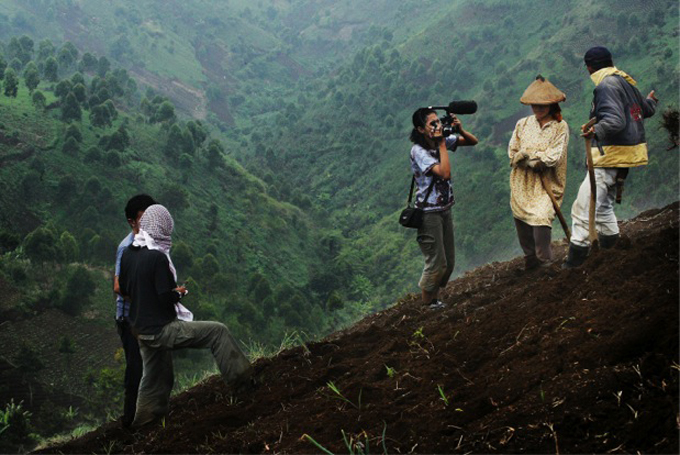Over the next months while the Design with the Other 90%: CITIES exhibition is on display at the United Nations Headquarters in New York several individuals whose own research explores the exhibition’s subject matter have been invited to write blog entries sharing their insights, related research and projects. – Cynthia E. Smith, Curator of Socially Responsible Design, Cooper-Hewitt, National Design Museum

The Global Lives Project team in Indonesia records the daily life of Dadah, an occasional farmer and mother of three in Sarimukti Village on the island of Java. Photo: © Antonius Riva Setiawan.
Rael Feliciano, Kai Liu and Jamila Jad have quite a few things in common. They each live at the rough edges of formal urban settlements. Rael's neighborhood, Jardim Iporanga, is a favela on the southern outskirts of São Paulo, where drug dealers and police are in a constant and often bloody tussle for power. Kai and his wife live in a small room at the back of a convenience store that they manage together – a bridge between their lives as rural farmers and peri-urbanites in Anren, a suburb of Chengdu, China. Jamila was born into refugee life in Shatila, a 62 year-old, UN-managed camp situated inside of Beirut, that has guaranteed Jamila and her family a life of material poverty with little hope of economic mobility. The three are also extremely generous souls—they have offered the world a very intimate invitation into their everyday realities as participants in the Global Lives Project. For twenty-four continuous hours, volunteer film crews watched patiently, recording every moment of their day. They and their families also gave detailed life story interviews, which anchored their daily lives in a rich and complex context.
Excerpt: Rael Feliciano, São Paulo, Brazil (Global Lives Project, 2006) Press the small "cc" button for English subtitles
Excerpt: Kai Liu, Anren, China (Global Lives Project, 2008) Press the small "cc" button for English subtitles
Excerpt: Kai Liu, Anren, China (Global Lives Project, 2008) Press the small "cc" button for English subtitles
The Global Lives videos allow the viewer a privileged vantage point from which to piece together the similarities and differences in the lives of these three individuals, as well as many others. Following Rael through winding alleyways as he heads to a Capoeira session in his neighborhood and watching Jamila as she plays paddleball in a strikingly similar corridor near her home, one might notice the parallels of improvised urban design, albeit on opposite sides of the planet. While only a few miles away from either location it would be easy to find modern mega-structures, these communities both share a common neglect on the part of urban planners in their regions. The neglect has consequences that go far beyond the aesthetic—basic services in these areas, from electricity to sewage to telecommunications are all lacking and, in turn, pose serious health threats and significant economic burdens on their residents. At first blush, it would be strange to compare Kai’s well-stocked convenience store in Anren to the smaller, more anemically appointed stores visited by Rael and Jamila in Jardim Iporanga or Shatila. But one critical element merits a closer look. In each of these cases, such stores are often directly connected to the homes of their owners, or, in Kai’s case, managers. Looking beyond the storefronts and into the living spaces behind or above them, we experience the inevitable coupling of commerce and intimate family life laid bare. Where those who are better off have the luxury of drawing at least an aesthetic boundary between labor and personal pursuits, those who live and work in urban peripheries often confront the fragile economics of their lives close at hand. Of course, these observations come from a very specific perspective—my own. What might look like suffering or injustice to me could be opportunity and privilege to someone else, and vice versa. I invite you to explore the Global Lives Project’s video library of human life experience and watch from your own perspective at http://globallives.org.
David Evan Harris is the Executive Director of the Global Lives Project and Research Director at the Institute for the Future.